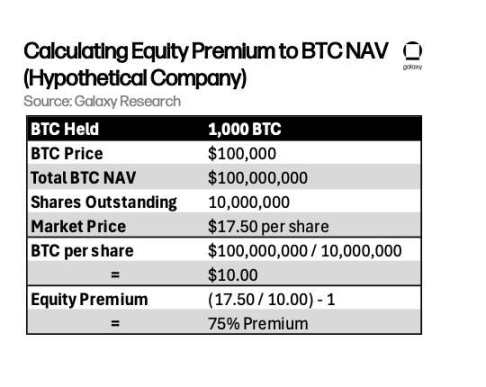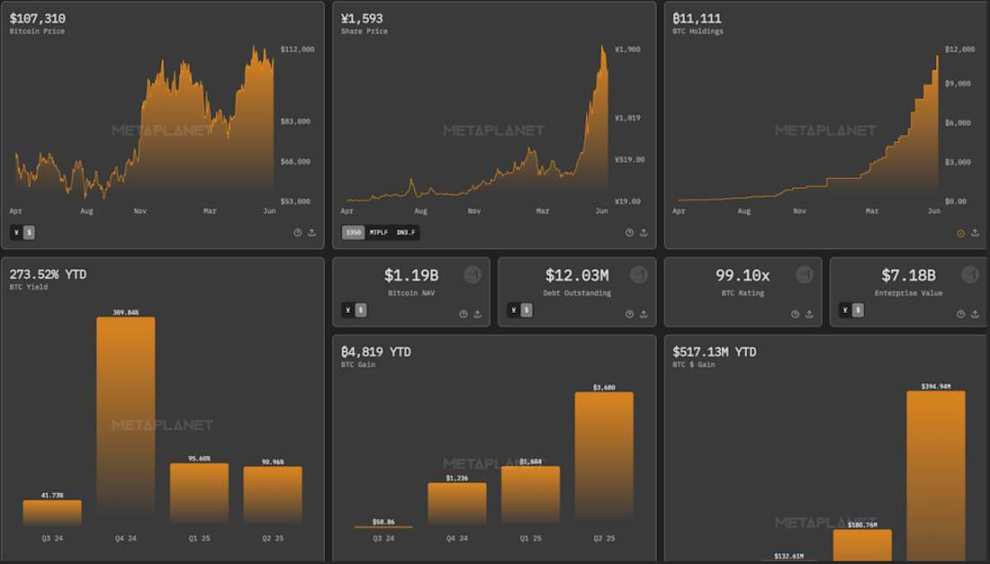Investors buying MSTR stock are not just purchasing Bitcoin; they are buying "the ability to continuously increase Bitcoin holdings in the future."
Written by: Will Owens, Galaxy
Translated by: AididiaoJP, Foresight News
Companies that incorporate Bitcoin into their balance sheets have become one of the most watched narratives in the public market by 2025. Although investors have various direct ways to gain exposure to Bitcoin (ETFs, spot Bitcoin, wrapped Bitcoin, futures contracts, etc.), many still choose to gain Bitcoin risk exposure by purchasing stocks of Bitcoin reserve companies that trade at a significant premium to their net asset value (NAV) of Bitcoin.
This premium refers to the difference between the company's stock price and the value of its Bitcoin holdings per share. For example, if a company holds $100 million worth of Bitcoin and has 10 million shares outstanding, its per-share Bitcoin NAV would be $10. If the stock price is $17.5, the premium rate would be 75%. In this context, mNAV (i.e., the multiple of net asset value) reflects how many times the stock price is compared to the Bitcoin NAV, while the premium rate is the percentage obtained by subtracting 1 from mNAV.
Ordinary investors may wonder: why can the valuations of such companies far exceed the value of their Bitcoin assets?

Leverage Effect and Capital Acquisition Ability
The most important reason for the premium of Bitcoin reserve company stocks over their Bitcoin assets may be that they can leverage through the public capital markets. These companies can raise funds to increase their Bitcoin holdings by issuing bonds and stocks. Essentially, they act as high-β proxy tools for Bitcoin, amplifying Bitcoin's sensitivity to market fluctuations.
The most commonly used and effective means in this strategy is the "At-the-Market" (ATM) stock issuance program. This mechanism allows companies to gradually issue shares at the current stock price, with minimal market impact. When the stock price is at a premium to the Bitcoin NAV, the amount of Bitcoin that can be purchased with each $1 raised through the ATM program will exceed the dilution of Bitcoin holdings per share caused by the issuance. This creates a "per-share Bitcoin holding appreciation cycle," continuously amplifying Bitcoin exposure.
Strategy (formerly MicroStrategy) is the best case for this strategy. Since 2020, the company has raised billions of dollars through convertible bond issuance and secondary equity fundraising. As of June 30, Strategy holds 597,325 Bitcoins (approximately 2.84% of the circulating supply).
These financing tools are only available to publicly listed companies, allowing them to continuously increase their Bitcoin holdings. This not only amplifies Bitcoin exposure but also creates a compounded narrative effect, where each successful fundraising and Bitcoin acquisition reinforces investor confidence in this model. Therefore, investors buying MSTR stock are not just buying Bitcoin; they are buying "the ability to continuously increase Bitcoin holdings in the future."
How Significant is the Premium?
The table below compares the premium situation of some Bitcoin reserve companies. Strategy is the publicly listed company with the most Bitcoin holdings globally and is the most well-known representative in this field. Metaplanet is the most aggressive Bitcoin accumulator (its transparency advantages will be detailed later). Semler Scientific entered this trend earlier, starting to purchase Bitcoin last year. Meanwhile, The Blockchain Group from France indicates that this trend is spreading from the U.S. to the global stage.
NAV premium rates of some Bitcoin reserve companies (as of June 30; assuming a Bitcoin price of $107,000):

Although Strategy's premium rate is relatively moderate (around 75%), the premium rates of smaller companies like The Blockchain Group (217%) and Metaplanet (384%) are significantly higher. These valuations indicate that market pricing reflects not only the growth potential of Bitcoin itself but also a comprehensive consideration of capital market access, speculative space, and narrative value.
Bitcoin Yield: A Key Indicator Behind the Premium
One of the core indicators driving the premium of these company stocks is the "Bitcoin yield." This indicator measures the growth of Bitcoin holdings per share over a specific period, reflecting the efficiency of increasing Bitcoin holdings using fundraising capabilities without causing excessive equity dilution. Metaplanet excels in transparency, providing a real-time Bitcoin data dashboard on its website, dynamically updating Bitcoin holdings, per-share Bitcoin holdings, and Bitcoin yield.

Source: Metaplanet Analytics (https://metaplanet.jp/en/analytics)
Metaplanet has publicly disclosed proof of reserves, while other companies in the industry have yet to adopt this practice. For example, Strategy has not implemented any on-chain verification mechanisms to prove its Bitcoin holdings. At the "Bitcoin 2025" conference in Las Vegas, executive chairman Michael Saylor explicitly opposed public reserve proof, stating that it would be a "bad idea" due to security risks: "This would undermine the safety of issuers, custodians, exchanges, and investors." This viewpoint is controversial, as on-chain reserve proof only requires the public key or address, not the private key or signature data. Since Bitcoin's security model is based on the principle of "public keys can be safely shared," publicly sharing wallet addresses does not jeopardize asset security (this is a characteristic of the Bitcoin network). On-chain reserve proof provides investors with a direct way to verify the authenticity of a company's Bitcoin holdings.
What Happens if the Premium Disappears?
The high valuations of Bitcoin reserve companies currently exist in a bull market environment characterized by rising Bitcoin prices and heightened retail enthusiasm. No Bitcoin reserve company's stock price has long-term fallen below NAV. The premise of this business model is the continuous existence of the premium. As VanEck analyst Matthew Sigel pointed out: "When the stock price falls to NAV, equity dilution will no longer be strategically meaningful and will become value extraction." This statement directly addresses the core vulnerability of the model; the ATM stock issuance program (the capital engine of these companies) essentially relies on stock price premiums. When the stock price is above the per-share Bitcoin value, equity fundraising can achieve an appreciation of Bitcoin holdings per share; however, when the stock price falls near NAV, equity dilution will weaken rather than enhance shareholders' Bitcoin exposure.
This model relies on a self-reinforcing cycle:
Stock price premium supports fundraising ability
Fundraising is used to increase Bitcoin holdings
Bitcoin accumulation strengthens the company's narrative
Narrative value maintains stock price premium
If the premium disappears, the cycle will be broken: financing costs will rise, Bitcoin accumulation will slow, and narrative value will weaken. Currently, Bitcoin reserve companies still enjoy advantages in capital market access and investor enthusiasm, but their future development will depend on financial discipline, transparency, and the ability to "increase per-share Bitcoin holdings" (rather than simply accumulating total Bitcoin). The "option value" that makes these stocks attractive in a bull market may quickly turn into a burden in a bear market.
免责声明:本文章仅代表作者个人观点,不代表本平台的立场和观点。本文章仅供信息分享,不构成对任何人的任何投资建议。用户与作者之间的任何争议,与本平台无关。如网页中刊载的文章或图片涉及侵权,请提供相关的权利证明和身份证明发送邮件到support@aicoin.com,本平台相关工作人员将会进行核查。




